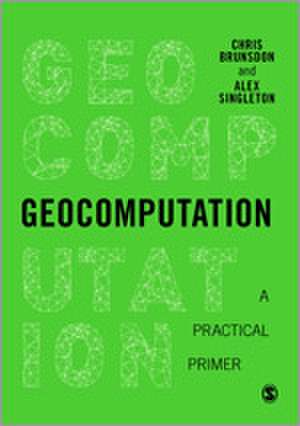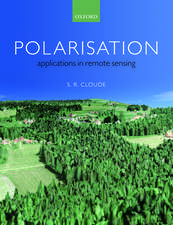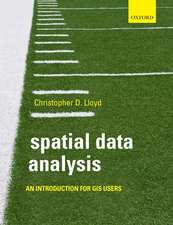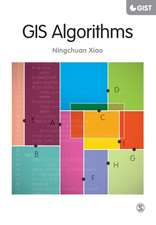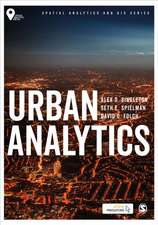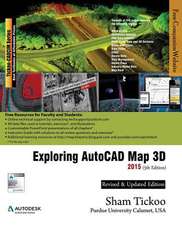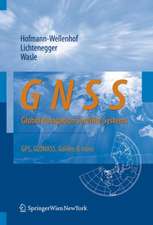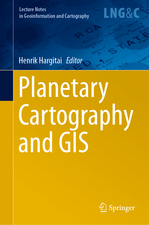Geocomputation: A Practical Primer: Spatial Analytics and GIS
Editat de Chris Brunsdon, Alex David Singletonen Limba Engleză Paperback – 21 ian 2015
- Provides a selection of practical examples of geocomputational techniques and ‘hot topics’ written by world leading practitioners.
- Integrates supporting materials in each chapter, such as code and data, enabling readers to work through the examples themselves.
- Visualisation and exploratory spatial data analysis
- Space time modelling
- Spatial algorithms
- Spatial regression and statistics
- Enabling interactions through the use of neogeography
This accessible text has been specifically designed for those readers who are new to Geocomputation as an area of research, showing how complex real-world problems can be solved through the integration of technology, data, and geocomputational methods. This is the applied primer for Geocomputation in the social sciences.
| Toate formatele și edițiile | Preț | Express |
|---|---|---|
| Paperback (1) | 456.60 lei 6-8 săpt. | |
| SAGE Publications – 21 ian 2015 | 456.60 lei 6-8 săpt. | |
| Hardback (1) | 1266.62 lei 6-8 săpt. | |
| SAGE Publications – 28 ian 2015 | 1266.62 lei 6-8 săpt. |
Preț: 456.60 lei
Preț vechi: 592.99 lei
-23% Nou
Puncte Express: 685
Preț estimativ în valută:
87.37€ • 91.64$ • 72.73£
87.37€ • 91.64$ • 72.73£
Carte tipărită la comandă
Livrare economică 01-15 aprilie
Preluare comenzi: 021 569.72.76
Specificații
ISBN-13: 9781446272930
ISBN-10: 1446272931
Pagini: 392
Dimensiuni: 170 x 242 x 15 mm
Greutate: 0.64 kg
Ediția:1
Editura: SAGE Publications
Colecția Sage Publications Ltd
Seria Spatial Analytics and GIS
Locul publicării:London, United Kingdom
ISBN-10: 1446272931
Pagini: 392
Dimensiuni: 170 x 242 x 15 mm
Greutate: 0.64 kg
Ediția:1
Editura: SAGE Publications
Colecția Sage Publications Ltd
Seria Spatial Analytics and GIS
Locul publicării:London, United Kingdom
Recenzii
This is a vital primer to what is ‘Big’ about geocomputation: new data (and lots of them), innovative methods of analysis, new geographic information technologies and, above all, an over-arching rethink of how we represent geography. It provides an important and strategic contribution to contemporary scientific geography and data analytics.
Brunsdon and Singleton offer a unique contribution to the zeitgeist of geocomputation. Geocomputation as a ubiquitous and quite novel field, is explored by the authors in a deductive and highly constructive fashion. The authors offer a wide array of applications brought by leading scholars in the field of Geographic Information Science, spatial analysis and spatial modelling. The role of new techniques that are revolutionizing the usage of geocomputation is well explored and the systematic approach the book adopts in envisioning available tools is appropriately constructed. This book is a great contribution for an advancing field, and a much welcomed achievement for the growth of a new kind of spatial science.
Brunsdon and Singleton offer a unique contribution to the zeitgeist of geocomputation. Geocomputation as a ubiquitous and quite novel field, is explored by the authors in a deductive and highly constructive fashion. The authors offer a wide array of applications brought by leading scholars in the field of Geographic Information Science, spatial analysis and spatial modelling. The role of new techniques that are revolutionizing the usage of geocomputation is well explored and the systematic approach the book adopts in envisioning available tools is appropriately constructed. This book is a great contribution for an advancing field, and a much welcomed achievement for the growth of a new kind of spatial science.
Cuprins
Introduction
Describing how the world looks
Spatial Data Visualisation with R - James Cheshire and Robin Lovelace
Geographical Agents in Three Dimensions - Paul Torrens
Scale, Power Laws, and Rank Size in Spatial Analysis - Michael Batty
Exploring movements in space
Agent-Based Modeling and Geographical Information Systems - Andrew Crooks
Microsimulation Modelling for Social Scientists - Kirk Harland; and Mark Birkin
Spatio-Temporal Knowledge Discovery - Harvey Miller
Circular Statistics - David Rohde and Jonathan Corcoran
Making geographical decisions
Geodemographic Analysis - Alexandros Alexiou and Alexander Singleton
Social Area Analysis and Self Organizing Maps - Seth Spielman and David Folch
Kernel density estimation and Percent Volume Contours - Daniel Lewis
Location-Allocation Models - Melanie Tomintz, Graham Clarke and Nawaf Alfadhli
Explaining how the world works
Geographically Weighted Generalised Linear Modelling - Tomoki Nakaya
Spatial Interaction Models - Karyn Morrissey
Python Spatial Analysis Library (PySAL): An Update And Illustration - Sergio Rey
Reproducible Research: Concepts, Techniques and Issues - Chris Brunsdon and Alex Singleton
Enabling interactions
Using Crowd-Sourced Information to Analyse Changes in the Onset of the North American Spring - Chris Brunsdon and Lex Comber
Open Source GIS software - Oliver O’Brien
Public Participation in Geocomputation to Support Spatial Decision Making - Richard Kingston
Conclusion
References
Describing how the world looks
Spatial Data Visualisation with R - James Cheshire and Robin Lovelace
Geographical Agents in Three Dimensions - Paul Torrens
Scale, Power Laws, and Rank Size in Spatial Analysis - Michael Batty
Exploring movements in space
Agent-Based Modeling and Geographical Information Systems - Andrew Crooks
Microsimulation Modelling for Social Scientists - Kirk Harland; and Mark Birkin
Spatio-Temporal Knowledge Discovery - Harvey Miller
Circular Statistics - David Rohde and Jonathan Corcoran
Making geographical decisions
Geodemographic Analysis - Alexandros Alexiou and Alexander Singleton
Social Area Analysis and Self Organizing Maps - Seth Spielman and David Folch
Kernel density estimation and Percent Volume Contours - Daniel Lewis
Location-Allocation Models - Melanie Tomintz, Graham Clarke and Nawaf Alfadhli
Explaining how the world works
Geographically Weighted Generalised Linear Modelling - Tomoki Nakaya
Spatial Interaction Models - Karyn Morrissey
Python Spatial Analysis Library (PySAL): An Update And Illustration - Sergio Rey
Reproducible Research: Concepts, Techniques and Issues - Chris Brunsdon and Alex Singleton
Enabling interactions
Using Crowd-Sourced Information to Analyse Changes in the Onset of the North American Spring - Chris Brunsdon and Lex Comber
Open Source GIS software - Oliver O’Brien
Public Participation in Geocomputation to Support Spatial Decision Making - Richard Kingston
Conclusion
References
Descriere
The only student focused, applied primer for Geocomputation in the social sciences. With example code and data sets provided as add-ons, it enables readers to work through all the examples themselves. An accessible text, specifically designed for readers who are new to Geocomputation as an area of research.
